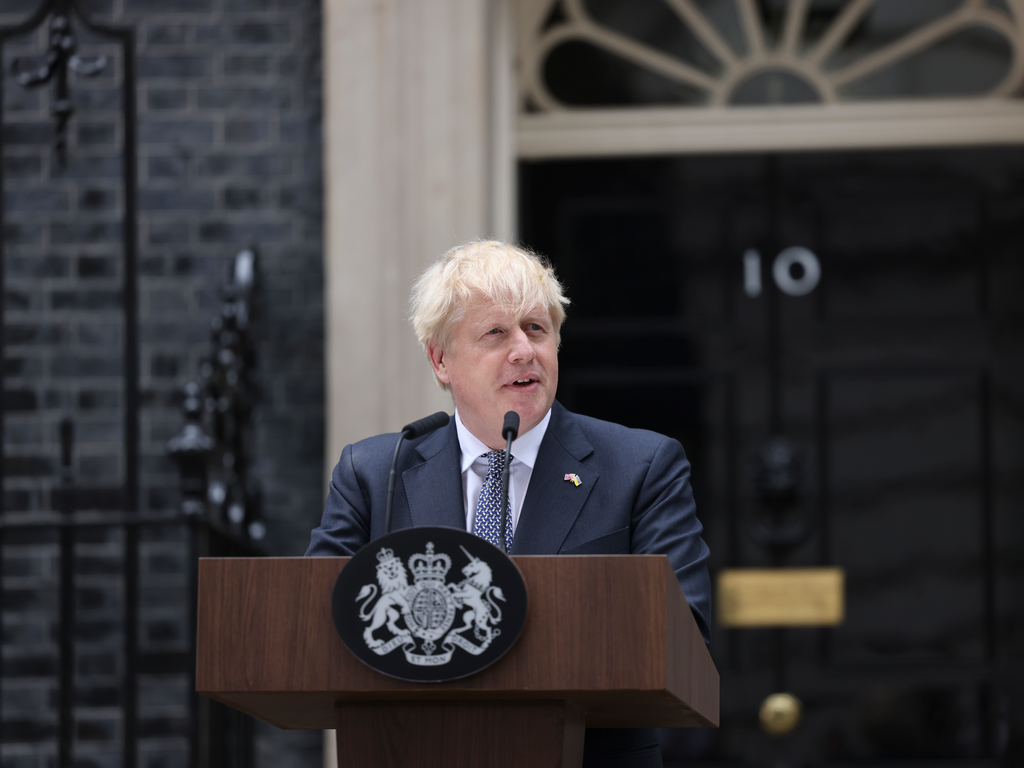
Boris Johnson announces his resignation: How It played out and what happens next
On July 7th, Boris Johnson's luck finally ran out, when dozens of members of his administration had quit or called for his resignation within a two day span. Johnson initially insisted during the first wave of resignations, that he should stay on as Prime Minister, arguing that the " record level of victory [in the 2019 General Elections] showed the people backed him", but he eventually decided to resign, amid an onslaught of cabinet members calling for his resignation, including cabinet members such as Sajid Javid (the Minister of Health), Michael Gove (former Leveling-Up Secretary), Priti Patel (former Home Secretary) and Rishi Sunak (former Chancellor of the Exchequer). Johnson explained his decision to resign as an inevitability, acknowledging that “It is clearly now the will of the parliamentary Conservative Party that there should be a new leader of that party” and described the escalating pressure he was under and his decision to resign, saying, “when the herd moves, it moves”.
Johnson became leader of the Conservative Party and Prime Minister of the United Kingdom (UK) in 2019 with a simple campaign slogan,“get Brexit done”, a simple promise to implement the decision that the British people had voted for in June of 2016 (51.9% leave, 48.1% stay), to exit the European Union. After more than 2 years had passed since the UK referendum, Johnson’s predecessor Theresa May, had still failed to reach an agreement with the EU that would deliver Brexit. Although Johnson initially struggled to pass his withdrawal deal past Parliament in October of 2019, he eventually passed it a few months later. The withdrawal agreement between the UK and EU officially took effect (in legal terms, this is when a treaty “enters into force”) on February 1st, 2020.
In general, assessing a leader’s economic legacy can be challenging, given the fact that many factors determine the economic health of a country (or the world) and many economic variables that influence the state of the economy, are out of the control of the leader. In Johnson’s case, it is particularly hard to assess Johnson’s legacy on the UK economy, given the unique and unforeseen COVID situation that developed, which forced countries around the world to mandate lockdowns, shutter businesses and curb tourism. So, it should be unsurprising the UK’s GDP growth showed the British economy shrank dramatically in 2020 (-9.3%), because COVID had such a negative economic impact across the world. Similarly, it is complicated to give any credit to Johnson for the strong rise in UK GDP growth in 2021 (+7.4%), because the UK government had begun distributing vaccines and opening society up, allowing previously forbidden economic sectors (such as nightlife or sports) to resume business, which lead to higher GDP growth. However, there has been a dramatic rise in inflation in the UK since 2021 (inflation rose 8.8% compared to July of 2021) although, it is unreasonable to place blame on Johnson for rising inflation in the UK, given how many countries have experienced inflation at a similar level or worse. Johnson was also lambasted for raising the payroll tax rates in September of 2021 by 1.25% for both workers and employers, and also increasing the tax rate for shareholder dividends by the same margin, breaking a campaign promise to refrain from increasing taxes. However, Johnson’s argument that he was forced to raise taxes because he felt “it would be irresponsible to [continue] to meet the costs of higher borrowing and higher debt”, has strong merit, given the large and unforeseen economic expense of combating COVID.
In January of 2021, Johnson was caught attending a party that featured alcohol and broke a lockdown imposed by his administration. This wasn’t the first time Johnson faced scrutiny for violating his own self-imposed COVID regulations. Prior to the gathering of January of 2021, there were a number of incidents in 2020, in which Johnson and members of his administration were caught flaunting the governments COVID laws, including one which took place on the same day that the UK government tweeted that citizens were “only permitted to meet someone outside their household, if the meeting was limited to two people, took place outdoors and those people remained 2 meters apart”. Johnson’s blatant and consistent socializing and drinking champagne amidst the draconian COVID regulations his government had been enforcing, led to a drop in support for Johnson. Although Johnson narrowly survived a ‘no confidence’ vote on June 6, earlier this year, Johnson’s leadership was on 'thin ice' with the party. A few months later, another scandal erupted when a number of allegations emerged of a cabinet official named Chris Pincher, groping and sexually harassing fellow cabinet members. The Chris Pincher scandal proved too much for Johnson to overcome, as many blamed the UK PM for his irresponsibility at appointing Pincher, who already had a reputation for fondling and sexually assaulting other MPs (Members of Parliament) and somehow was still appointed to a position in the cabinet.
The announcement of his resignation indicates that the end of Boris Johnson's time as Prime Minister of the UK was arriving shortly, beginning a new contest amongst the leadership of the Conservative Party (sometimes called the Tories) for leadership of the party and the position of UK Prime Minister. The reason why the departure of Johnson hasn’t led to public elections is because in the UK there is a general election at least once every 5 years unless the current majority party decides to call elections (to get a stronger mandate to govern from the public). During the general election, UK citizens vote for MPs that will represent their individual constituencies. A constituency is a specific geographical area that elects a specific leader to represent their area in parliament. The party that wins the most constituencies/MP elections (a majority) in parliament, is given the right to select the next Prime Minister. Public elections can be held before the end of the 5 year waiting period, if any of the following scenarios take place: 1) the leader of the majority party calls for new elections or 2) if there is a vote of no-confidence in the current government that passes with a majority in Parliament.
An internal leadership contest (only Tory members and Tory MPs can participate) will take place if the leader resigns or is forced out by other members of the party through an MP putting forth his candidacy (requirement is 20 MPs’ signatures). Tories elect their leader through a two step process. First, the Conservative MPs hold an internal election amongst themselves and have a vote to decide which two candidates will go on to the next round. In the 2nd round of the nomination contest, the rest of the approximately 200,000 party members are eligible to vote to select their next leader. Following Johnson’s resignation, Tory MPs have already chosen the two candidates who will be the finalists for the 2nd round, which will take place this year on September 5th.
The current favorite to win, Rishi Sunak, is the former chancellor of the exchequer (similar to the Secretary of the Treasury in the US) and a rising star in the party, since he was elected to the House of Commons in 2015. Sunak was appointed by Johnson to be Chief Secretary of the Treasury in July of 2019, making him the 2nd highest ranking official in the treasury, soon after (February of 2020), he was promoted to lead the treasury, replacing the recently fired and former Chancellor of the Exchequer Sajid Javid. Despite Sunak’s impressive resume which includes degrees from Oxford and Stanford and successful stints in the finance world, Sunak’s candidacy does come with some concerning flaws and his approval rating has dropped heavily in recent months (26% favorable, 44% unfavorable in April this year), which is a concerning sign for Sunak’s chances of being elected by his fellow Tories in September.
The other candidate is Liz Truss, the current foreign secretary, who was a rare Johnson loyalist within the cabinet, resisting pressure from the rest of her party to quit or call for his resignation. Truss has been a Conservative MP since 2010, when she was elected to represent South West Norfolk. Like Sunak, Truss attended Oxford, served as chief secretary of the treasury (Sunak’s predecessor) and served in a range of different cabinet roles before mounting a bid for the leadership.
There are understandable explanations for Sunak’s recent fall from public grace. Sunak is still heavily tied to the economic legacy of Johnson’s administration, because he served in the 2 most senior positions in the Treasury for Johnson’s government and shares a degree of responsibility for the government’s economic policies over the last few years. It would be strange if Tory voters looking for a change in economic strategy and upset by the government's economic policies over the last few years (for example, Johnson’s large tax raise), decided to back Sunak, considering his involvement in setting those policies. Furthermore, like Johnson, Sunak was also fined for breaking COVID regulations. Similar to Sunak, Truss’s legacy is also intertwined with Johnson to a degree. Given her stalwart support for Johnson, she may be too strongly associated by voters with the outgoing PM, whose administration she continued to support, even as Johnson’s hold on the leadership was slipping rapidly. Although Sunak is considered as the most likely candidate to be chosen as the next Tory leader, Truss still has a strong chance to win. In less than a week, Tory members will get to choose from 2 candidates who have ties to Johnson that are a bit too close for comfort and select their least disliked candidate to become the next Prime Minister of the United Kingdom.
